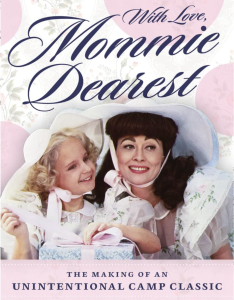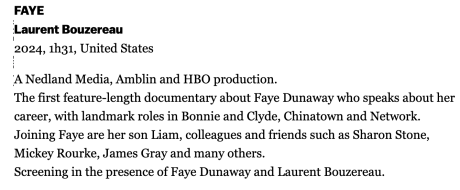Two new pop-throughs on the Faye Dunaway front: (1) A. Ashley Hoff‘s “With Love, Mommie Dearest: The Making of an Unintentional Camp Classic” (Chicago Review Press, 5.7.24), and (2) Faye, Laurent Bouzereau‘s sure-to-be-softballed profile doc that will premiere during the upcoming Cannes Film Festival. Dunaway and Bouzereau will attend the Cote d’Azur screening.
HE comment #1: Dunaway’s career hit a kind of pothole when Mommie Dearest came out, agreed, but I just re-watched it a couple of weeks ago and certain portions are still a hoot. For my money the film is a hugely pleasurable serving of classic Hollywood Kabuki theatre.
I saw it with several gay guys at the old Columbus Circle Paramount screening room in late August of ’81, and on the down elevator they were all shrieking with laughter, and I don’t mean the derisive kind. They were in heaven…delighted.
Alas, Mommie Dearest has been called an “unintentional comedy” by none-too-brights for so long that it looks like up to me, and I’m sorry but that judgment is just as wrong today as it ever was.

The Mommie Dearest “comedy” is not unintentional. The film basically serves a form of hyper-realism with a campy edge. It’s extreme soap opera, at times overbaked but winkingly so with everyone in on the joke.
If director Frank Perry had modulated Dunaway’s performance, some of the great lines — ‘No wire hangers EVER!,’ ‘Don’t fuck with me, fellas!’ — wouldn’t have worked so well. Those lines are the stuff of Hollywood legend, right up there with Bette Davis saying “what a dump!” and Vivien Leigh saying “I’ll never be hungry again.”

HE comment #2: Dunaway has been a first-rate actress since the early ’60s, and at age 83 is still at it, of course. But her peak years were close to 15 — Bonnie and Clyde (’67) to Mommie Dearest (’81). Her other highlights include The Thomas Crown Affair (fellatio simulation with a chess piece), The Arrangement, Little Big Man, Puzzle of a Downfall Child, The Three Musketeers, Chinatown, The Towering Inferno (the second best ’70s disaster flick, right after Juggernaut), The Four Musketeers, Three Days of the Condor and Network (Best Actress Oscar…the absolute peak).
Please understand that while some superstars have enjoyed 20-year peaks (Cary Grant, James Stewart, George Clooney), 15 is far more common so there’s certainly nothing tragic or mortifying about Dunaway’s career cooling down in the early Reagan era. Remember also that she rebounded with her Barfly performance in ’87, and that she landed three Golden Globes in the ’80s and an Emmy in ’94.
Clark Gable’s hottest years numbered 13 — between It Happened One Night (‘34) and The Hucksters (‘47). Humphrey Bogart happened between The Maltese Falcon (‘41) and The Harder They Fall (‘56) — a 15-year run. Robert Redford peaked between Butch Cassidy (‘69) and Brubaker and Ordinary People (‘80) — 11 to 12 years. Tony Curtis‘s hot streak was relatively brief — 1957 (Sweet Smell of Success) to 1968 (The Boston Strangler). Kirk Douglas also had about 15 years — Champion (’49) to Seven Days in May (’64).
Elizabeth Taylor had 15 years — 1950 (Father of the Bride) to 1966 (Who’s Afraid of Virginia Woolf). Jean Arthur — mid ’30s to early ’50s (Shane) — call it 15 years. Katharine Hepburn — early ’30s to early ’80s (On Golden Pond). Meryl Streep — 1979 (The Seduction of Joe Tynan) to today…over 40 years and counting.
It’s a basic creative and biological law that only about 10% to 15% of your films are going to be regarded as serious creme de la creme…if that. Most big stars (the smart ones) are given a window of a solid dozen years or so in which they have the power, agency and wherewithal to bring their game and show what they’re worth creatively. Dunaway certainly managed that and then some.












